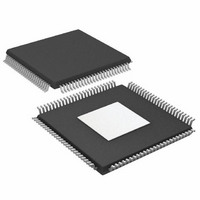AD9778ABSVZ Analog Devices Inc, AD9778ABSVZ Datasheet - Page 38

AD9778ABSVZ
Manufacturer Part Number
AD9778ABSVZ
Description
IC,D/A CONVERTER,DUAL,14-BIT,CMOS,TQFP,100PIN
Manufacturer
Analog Devices Inc
Specifications of AD9778ABSVZ
Number Of Bits
14
Data Interface
Parallel
Number Of Converters
2
Voltage Supply Source
Analog and Digital
Power Dissipation (max)
300mW
Operating Temperature
-40°C ~ 85°C
Mounting Type
Surface Mount
Package / Case
100-TQFP Exposed Pad, 100-eTQFP, 100-HTQFP, 100-VQFP
Package
100TQFP EP
Resolution
14 Bit
Conversion Rate
1 GSPS
Architecture
Interpolation Filter
Digital Interface Type
Parallel
Number Of Outputs Per Chip
2
Output Type
Current
Full Scale Error
±2(Typ) %FSR
Integral Nonlinearity Error
±1.5(Typ) LSB
Lead Free Status / RoHS Status
Lead free / RoHS Compliant
For Use With
AD9778A-EBZ - BOARD EVALUATION AD9778A
Settling Time
-
Lead Free Status / RoHS Status
Lead free / RoHS Compliant
Available stocks
Company
Part Number
Manufacturer
Quantity
Price
Company:
Part Number:
AD9778ABSVZ
Manufacturer:
Analog Devices Inc
Quantity:
135
Company:
Part Number:
AD9778ABSVZ
Manufacturer:
Analog Devices Inc
Quantity:
10 000
Part Number:
AD9778ABSVZ
Manufacturer:
ADI/亚德诺
Quantity:
20 000
Company:
Part Number:
AD9778ABSVZRL
Manufacturer:
Analog Devices Inc
Quantity:
10 000
AD9776A/AD9778A/AD9779A
As shown in Table 20, the mixing functions of most of the
modes result in cross-coupling of samples between the I and Q
channels. The I and Q channels only operate independently
with the f
the I and Q DAC outputs can only be done in the f
other modulation modes require complex input data and
produce complex output signals.
Table 20. Modulation Mixing Sequences
Modulation
f
f
−f
f
INVERSE SINC FILTER
The inverse sinc filter is implemented as a nine-tap FIR filter. It
is designed to provide less than ±0.05 dB pass-band ripple up to
a frequency of 0.4 × f
upper end of the pass band, the inverse sinc filter has an intrinsic
insertion loss of 3.4 dB. The transfer function is shown in
Figure 71 and the tap coefficients are given in Table 21.
DAC
DAC
DAC
DAC
/2
/4
/8
/4
S
/2 mode. This means that real modulation using both
Mixing Sequence
I = I, −I, I, −I, …
Q = Q, −Q, Q, −Q, …
I = I, Q, −I, −Q, …
Q = Q, −I, −Q, I, …
I = I, −Q, −I, Q, …
Q = Q, I, −Q, −I, …
I = I, r(I + Q), Q, r(−I + Q), −I, −r(I + Q), −Q, r(I − Q),
…
Q = Q, r(Q − I), −I, −r(Q + I), −Q, r(−Q + I), I, r(Q + I),
…
where r = √2/2
DATA
. To provide the necessary gain at the
S
/2 mode. All
Rev. B | Page 38 of 56
Table 21. Inverse Sinc Filter
Lower Coefficient
H(1)
H(2)
H(3)
H(4)
H(5)
The inverse sinc filter is disabled by default. It can be enabled by
setting the inverse sinc enable bit (Bit 3) in Register 0x02.
Figure 71. Transfer Function of Inverse Sinc Filter with the DAC sin(x)/x Output
–0.5
–1.0
–1.5
–2.0
–2.5
–3.0
–3.5
–4.0
–4.5
0
0
0.05
0.10
COMBINED SINC AND SINC
0.15
Upper Coefficient
H(9)
H(8)
H(7)
H(6)
N/A
SINC
0.20 0.25
–1
f/f
RESPONSE
SAMPLE
0.30 0.35
–1
RESPONSE
0.40
Integer Value
+2
−4
+10
−35
+401
0.45 0.50













